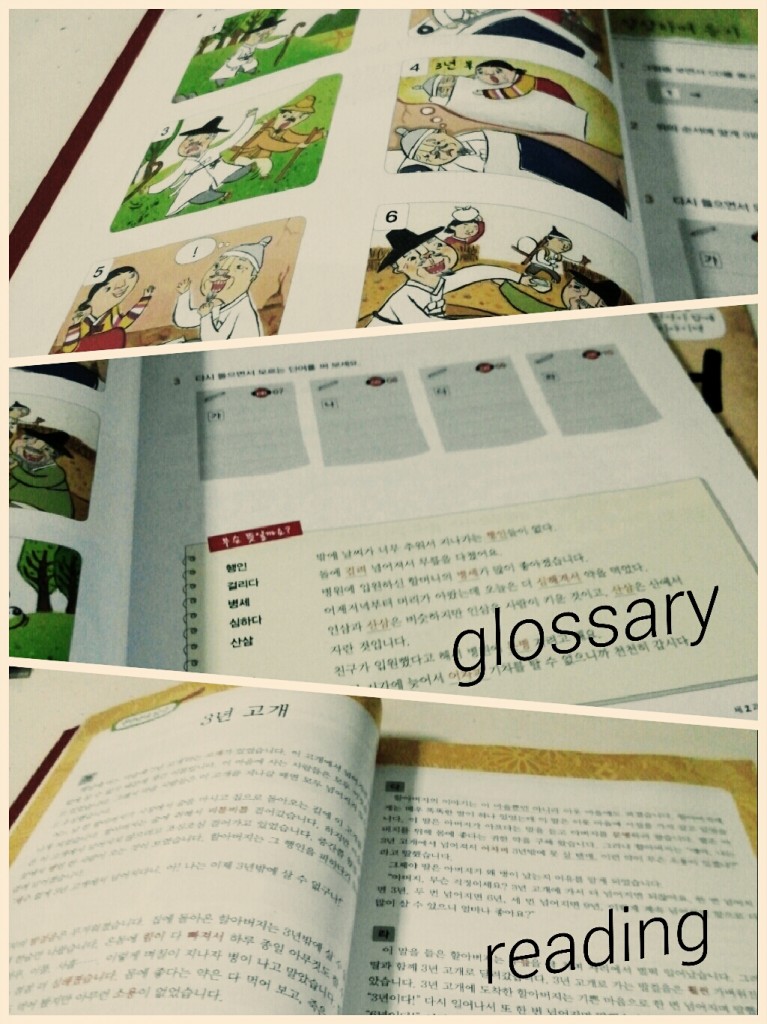Sick of ‘generic’ Korean textbooks with boring, everyday-life dialogues? Want to learn Korean and at the same time get to read up on Korean folktales?
전래 동화로 배우는 한국어 may be just the right book for you!
I realised that I own (or have used) quite a number of books from the publisher Darakwon.
(ooh this is the shortest introduction in my textbook review posts lol)
As usual, scroll right to the bottom for a summary if you wanna skip all my detailed analysis ㅎ
Unlike other textbooks that name their chapters according to themes (eg. School, Visit to the Doctor), each chapter is a Korean folktale and they are grouped into 3 main categories: Interesting stories with moral values behind them, folktales with magical/fantasy elements and Korean traditional classic folktales.
Like many other Korean textbooks, this book can’t seem to decide whether it’s trying to be suitable for classroom use or self studying use. Or maybe it tries to cater for both and ends up being a step shy of both sides.
Each chapter opens with a set of pictures asking you to look and describe what you think is going on in each. (not like I’m going to do it o.O). The pictures actually tell a story but they are all jumbled up so you have to …. yes. FIGURE THE ORDER.
In order to do so, listen to the CD!
I really like how the book is structured in a way that you are being forced to listen before you see the transcript. I love how the book makes use of folktales – which includes both dialogues and narration – for their listening practice. It’s harder than listening to pure dialogues and hence a better challenge.
The folktale is of decent length, so you get around 5 mins plus of listening practice each time. Way longer than most textbooks ^^ It’s like listening to an audio book, so none of those awkward monotonous speakers.
I love how the glossary is not just the usual “word + meaning” list. They actually just give you the word, an example sentence and then ask you to figure out the meaning on your own. All textbooks should do that! /approves
The transcript is on the next page, so it helps to train your listening ability first before you refer to the transcript. The passage is broken into a few parts, which makes it look a lot more accessible, so you won’t get afraid at the huge chunk of Korean at one go.
Followed by ‘standard exercises’ that I usually conveniently ignore. Personally I hate exercises asking me to summarize the passage. maybe that’s why I suck at it?
I both like and dislike the way they present the grammar section.
It’s great that they have the Korean explanation, followed by an example sentence in the grey box. And then 4 sentences where you are supposed to conjugate and fill in the grammar point in the sentence. (answers in the book) Which is all great, because they are essentially more example sentences and you get to remember them better because you get to think and then write the answers in.
But their explanations are all one-liners. It all looks good to me (as someone who already know them) but I wonder if the explanations are enough for a self learner?
[Don’t worry about the book being all in Korean. There’s a booklet that has all the translations of the transcripts and grammar explanations in English, Chinese and Japanese]Then you get the same set of pictures again and you are asked to create a simple dialogue for each picture. (err. not doing it)
Followed by more exercises that I usually ignore heh.
An interesting feature is the checklist nearing the end of each chapter. Basically you are asked to tick which words (featured in the chapter) you know now, if you know the word to be used in each sentence given (part 2), and how well you think you know chapter (part 3).
I can summarize <(name of folktale)> : good, fair,poor
LOL.
Not my style, but I applaud the effort and it could work for some.
Each chapter then ends with something fun. Interesting tips, fun quizzes etc.
This textbook is not without its faults (the exercises that seems to cater to neither classroom learning nor self study use), but these faults are common in language textbooks in general and hence I don’t really blame it for being so.
The interesting dialogues, coupled with the effort taken to engage the learner and prompt the learner to take some active steps to learn and to manage his/her progress, gets my stamp of approval. (I hate books that spoon-feed)
Things I like:
- Good quality pictures, paper (important)
- Well structured, ample space to write and take additional notes
- Awesome folktales used as listening / reading practice
- Progressively longer folktales at the back chapters
- Glossary that lets you figure out the meaning of the words on your own (i.e. check the dictionary)
- Grammar section that makes you fill in the blanks yourself (with answers at the back)
- Generally fun and less tedious to work through compared to other textbooks
Things that can be improved:
- Less exercises, or exercises that people really do in classrooms
- More detailed grammar explanations
All in all, pretty much recommended! 😀
If you are interested in purchasing the book, head over to Twochois!
Link: Twochois Online Korean bookstore
Link: Other Darakwon books available
Hope you liked this review~!







No Comments